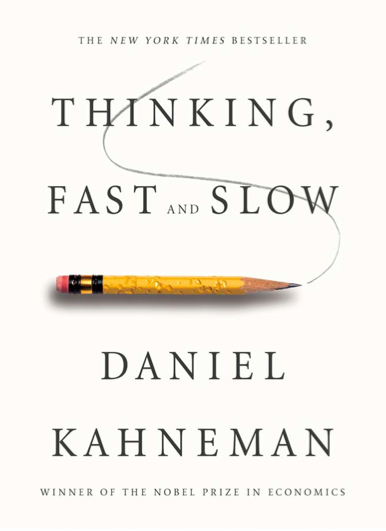One of the most insightful books I read in the last years.
The book consists of 5 parts.
In Part 1, Kahneman makes a distinction between the two systems we use to make choices and judgments: the automatic System 1 and the controlled System 2. In this part, he covers, among others the concepts of flow, ego depletion, priming, the Halo effect and WYSIATI.
My take-away:
Make making the right choice easy (Richard H. Thaler and Cass R. Sunstein also explore this idea in their book Nudge).
In part 2, he explains how our thinking process works. We think associatively and metaphorically. As a result, many of us are very bad at thinking statistically. However, most of us have a hard time admitting this fact. Some of the topics of this part are the law of small numbers, anchors and the availability cascade.
My take-away:
It’s easier to convince people of something by showing them representative cases than by showing statistics.
In part 3, Kahneman further elaborates on the idea of our limited capacity to think statistically. This part is especially interesting for project and program managers. He provides examples of our overconfidence in what we believe we know and our inability to acknowledge that misguided confidence. He talks about intuition from both non-specialists and experts. He introduces the concepts “project pre-mortem”, planning fallacy and competition neglect.
My take-aways:
- Consciously inviting an outside view and analysing reference cases mitigates the planning fallacy.
- Simple formulas can often replace human judgment. However, this statement is often met with a lot of hostility. I have to admit that it still inflicts me with a “rebellious” feeling, even after reading the book.
- Intuition can only be gained in regular environments which provide clear and immediate feedback.
Part 4 handles the false assumption that our (economic) decisions are rational. Here Kahneman talks about risk aversion, the endowment effect, the power of rare but vivid events, framing and mental accounting.
My take-away:
People are risk-averse, and it is vital to take this proclivity into account when communicating in during organisational changes. E.g. It is better to communicate that a team can work from home 1 day per week but in reality extend to 2 days than to promise three days and revert to 2 days. Although the end result is the same, people will consider the first situation as a win and the second as a loss. And this will inevitably create friction.
Part 5 introduces the distinction between our two selves: the “experiencing self” and the “remembering self”.
My take-aways:
- Storytelling is a very potent tool for change management.
- It is essential to show empathy after bringing bad news.
Why read it?
The book is rooted in scientific research, easy to understand and packed with applicable insights for leaders and change managers. Kahneman writes in a clear language and builds up his argumentation step-by-step often starting from a catching story or experiment.

